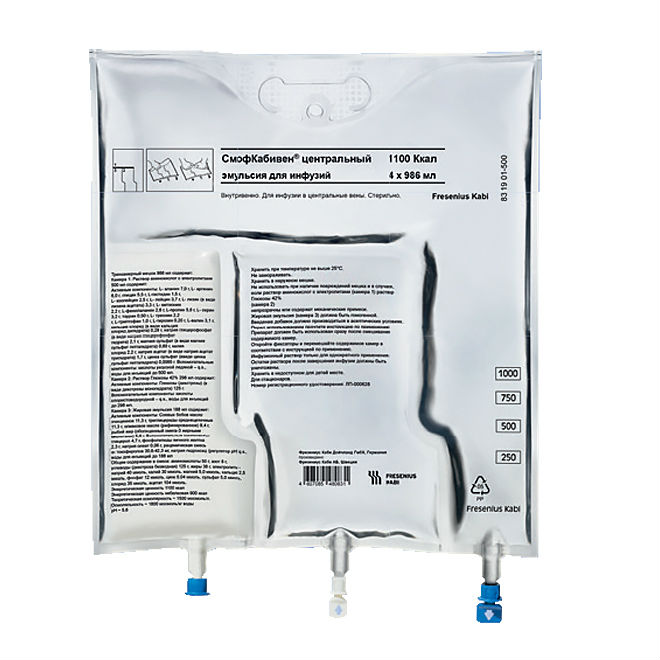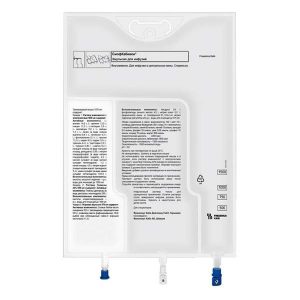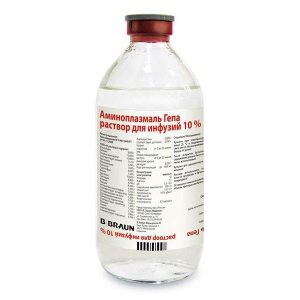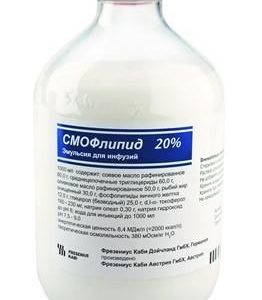Description
Release form
Three-chamber bag with solutions of amino acids, glucose and fat emulsion.
packaging 4 pcs
Pharmacological action
CMOfcabiven central – a combined preparation for parenteral nutrition. The pharmacological properties of the drug are determined by its composition.
Fat emulsion
Fat emulsion SMOFKabiven central includes SMOFlipid (SMOF – SMOF is an abbreviation that includes the first letters of oil sources, which are part of the preparation: Soya oil – Soybean oil, Medium chain triglycerides MCT – medium chain triglycerides, Olive oil – Olive oil, Fish oil – fish oil), which is identical in particle size and biological properties to endogenous chylomicrons. The components of the SMOF fat emulsion are central, soybean oil, medium chain triglycerides, olive oil and fish oil, in addition to differences in composition and energy density, have their own pharmacodynamic properties.
Soybean oil contains a large amount of essential fatty acids. It is most rich in linoleic acid (approximately 55-60%), which is a -6 fatty acid. 8% of the composition of soybean oil is represented by -Linolenic acid, which is -3 fatty acid. Fat emulsion, which is part of the drug, SMOFKabiven central, provides the necessary amount of essential, fatty acids.
Medium chain fatty acids provide the body with rapidly available energy due to their ability to oxidize quickly.
Olive oil supplies energy in the form of monounsaturated fatty acids, which are much less susceptible to oxidation than the corresponding amount of polyunsaturated fatty acids.
Fish oil is high in eicosapentaenoic (EPA) and docosahexaenoic (DHA) acids. DHA is an important structural component of cell membranes, and EPA is a precursor to eicosanoids such as prostaglandins, thromboxanes and leukotrienes.
Amino acids and electrolytes
Amino acids are part of the proteins of ordinary food and are used by the body to synthesize proteins in tissues, and their excess is metabolized by a number of biochemical pathways. Studies indicate a thermogenic effect in / in the introduction of amino acids.
Dextrose
Glucose (dextrose) is an indispensable source of rapidly released energy, which is necessary, among other things, for the metabolism of amino acids.
Pharmacokinetics
Fat emulsion
Different triglycerides in SMOFlipid have different clearance indicators, but SMOFlipid is eliminated on average (as a mixture) faster than long-chain triglycerides (LCT). The lowest clearance indicator of all SMOFlipid components is in olive oil (slightly lower than that of LCT), and the highest clearance is in medium chain triglycerides (MCT). Fish oil in an LCT mixture has the same clearance as pure LCT.
Amino acids and electrolytes
The pharmacokinetic characteristics of amino acids and electrolytes administered iv are the same as when they are taken with food. However, the amino acids of food proteins first enter the portal vein of the liver, and only then into the systemic circulation, while the amino acids introduced into the vein enter directly into the systemic circulation.
Dextrose
Pharmacokinetic characteristics of glucose (dextrose), administered by infusion, are the same as when it was received with ordinary food.
Indications
Parenteral nutrition for adults and children (from the age of 2 years), primarily patients in critical conditions
Contraindications
severe hyperlipidemia
severe hepatic insufficiency
severe coagulation disorders
congenital disorders of amino acid metabolism
severe renal failure without access to hemodialysis or hemofiltration acute blood pressure acute blood pressure composition of the
electrolyte preparation general contraindications to infusion therapy: acute pulmonary edema, hyp rgidratatsiya, decompensated cardiac insufficiency and hypotonic dehydration
gemafagotsitarny syndrome / macrophage activation syndrome
unstable state (e.g., post-traumatic condition, uncompensated diabetes, acute myocardial infarction, decompensated metabolic acidosis, septic shock and hyperosmolar coma)
hypersensitivity to egg or soy proteins, fish oil or any auxiliary component of the drug.
Dosage and administration
Before use, divide the partitions and mix the contents of the three chambers. The drug should be injected into the central veins.
Adults: A centralized dose of SMOFkabiven from 13 to 31 ml / kg / day corresponds to a nitrogen content of 0.10-0.25 g / kg / day (0.6-1.6 g / kg / day of amino acids) and a total energy of 14 -35 kcal / kg / day (12-27 kcal / kg / day of non-protein energy). Such doses meet the needs of most patients. The maximum daily dose is 35 ml / kg / day.
Children: Infusion in children (2 to 10 years old) should begin with low doses (14-28 ml / kg / day), the dose should be increased by 10-15 ml / kg / day. The maximum daily dose is 40 ml / kg / day.
Side effects of
From the cardiovascular system: tachycardia, increase or decrease in blood pressure.
From the respiratory system: shortness of breath.
From the digestive system: impaired appetite, nausea, vomiting, increased activity of liver enzymes in plasma.
From the nervous system: headache, dizziness.
Allergic reactions: anaphylactic and anaphylactoid reactions, skin rash, urticaria, fever, chills.
Local reactions: local temperature increase, hyperemia.
Drug Interactions
Some drugs, such as insulin, may interact with the body s lipase system. However, this type of interaction has limited clinical value.
Heparin at therapeutic doses causes a temporary release of lipoprotein lipase into the bloodstream. This can lead to increased plasma lipolysis, followed by a decrease in triglyceride clearance.
Soybean oil contains vitamin K1. However, its content in SMOFKabiven central is so low that its effect on blood coagulation in patients receiving indirect anticoagulants is negligible.
Overdose of
Fat overload syndrome
Impaired ability to metabolize triglycerides can lead to the development of fat overload syndrome, which can be caused by an overdose of lipids. You should pay attention to possible signs of metabolic overload. The causes of impaired lipid metabolism may be genetic (individual metabolic changes), in addition, present or previous diseases can affect fat metabolism. High hypertriglyceridemia and fat overload syndrome can develop even at the recommended rate of administration of the drug if the patient s clinical condition suddenly changes (for example, renal function is impaired or infectious complications develop
). Fat overload syndrome is characterized by hyperlipidemia, fever, fatty liver infiltration, hepatomegaly with or without jaundice, splenomegaly, anemia, leukopenia, thrombocytopenia, blood clotting disorders, hemolysis and reticulocytosis, impaired laboratory parameters of liver function and coma. Symptoms are usually reversible and stop when the infusion of the fat emulsion is stopped.
Introduction of large quantities of amino acids
As with other amino acid solutions, when exceeding the recommended infusion rate with SMOFKabiven central, the amino acids contained in it can lead to undesirable effects. Perhaps the development of nausea, vomiting, chills, and increased sweating. Amino acid infusion can also cause fever. In case of impaired renal function, concentrations of nitrogen-containing metabolites such as creatinine and urea may increase.
Excessive administration of dextrose
If the dextrose infusion rate exceeds its clearance threshold, the patient will develop hyperglycemia.
With the development of symptoms of overload with fat or amino acids, the infusion of SMOFKabiven Central should be stopped or its speed reduced. With an overdose of these drugs, there is no specific antidote. Urgent measures for an overdose of lipids and amino acids come down to life support measures with special attention to the respiratory and cardiovascular systems. In addition, careful biochemical monitoring and the treatment of specific metabolic disorders are necessary.
If hyperglycemia occurs, it is necessary to conduct therapy in accordance with the clinical situation by administering short-acting insulin and / or adjusting the infusion rate of SMOFKabiven central drug.
An overdose can also lead to fluid overload, an electrolyte imbalance, and a hyperosmolar state. In rare cases, if these symptoms become severe, hemodialysis, hemofiltration, or hemodiafiltration should be considered.
Storage conditions
The drug should be stored out of the reach of children at a temperature not exceeding 25 ° C. Do not freeze. Store in outer bag.
Term hodnosty
2 years
Conditions of supply of
Pharmacy Prescription
Dosage form
solution for infusions
Fresenius Kabi, Germany




